|
|
Propagation of the Radio Waves |
|
|
|
The radio waves are a kind of electromagnetic radiation similar to the sound waves and the visible light, but differing from these with respect to the form how they are generated and detected (i.e. transmitted and received), as well the form how they are propagated in the space, at a velocity of 300,000 km/s, approximately (it is the velocity of light). The radio waves can be reflected, refracted and difracted, and commonly present loss of energy due to factors such as the frequency being used, the distance, the attenuation in the free space, and others. Propagation ModesThe radio waves, depending on the frequency being utilized, are propagated in different modes:
Terrestrial AtmosphereIn order to understand how proceeds the propagation, it is important to known the composition of the terrestrial atmosphere and the factors that affect it. The atmosphere is divided into three layers. The inner layer is the troposphere, extending up to an altitude of 11 km. Your influence in the propagation is done by means of attenuation due to raindrops, snow, hailstorm, etc. The medium layer is the stratosphere, that extends up to an altitude of 50 km, and has negligible effects in the propagation. The upper layer is the ionosphere, extending up to an altitude of 400 km. This layer, concerning to shortwave broadcasting, is the most important. TroposphereThe troposphere is where occurs every sort of weather phenomena. Ionization is pratically inexistent in this layer. Usually the troposphere is characterized by constant variation of temperature and pressure, as well the reduction of its density as the altitude increases. The refraction of the radio waves in the troposphere is done in function of several meteorological variables. Due to the irregular heating of the surface the air is in constant movement, causing turbulences, that with the increasing of the altitude become less intense. These turbulences have little effect in the transmitted waves in frequencies below 30 MHz (that is, below HF band), because the wavelenght is big enough with respect to the turbulence. When a wave passes through the troposphere and encounters a turbulence, a certain quantity of energy of the transmitted wave is scattered. How only a small portion of energy is reirradiated by the turbulence, the power level of the irradiated signal is extremely low, resulting in a low efficience. The characteristics of propagation in the troposphere vary over certain weather conditions, and can stay invariable for a long time. In higher altitudes constantly occur temperature inversions, for several reasons (e.g. a mass of hot air passing over a mass of cold air, the rapid cooling of the terrestrial surface during the evening, the heating of the air above the clouds due to the reflection of the solar rays in its upper surface). These temperature inversions cause radical refractions, with the transmitted wave being refracted continuously in the upper and lower boundaries of the inversion. Then, it is created a "tropospheric duct" when the waves are retained by considerable distances, until the inversion is normalized. Although the transmission by tropospheric ducts be highly desirable, it is not frequently used due to the unexpected occurrence of these ducts. |
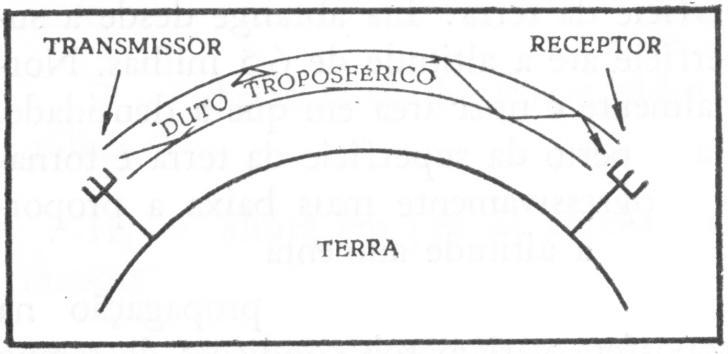
|
StratosphereThe stratosphere, located between the troposphere and the ionosphere, presents constant temperature (hence also called isothermic region). Besides, it is not subjected to temperature inversions, neither it can cause significative refractions. For propagation purposes this layer is considered pratically inert. IonosphereThe ionosphere is a non-homogeneous layer, being divided into three sub-layers, or regions, that vary during a day. This variation occurs because this layer, due to its low densith of gases (i.e. molecules of the atmosphere), it presents a big quantity of ions (atoms or molecules that suffered loss or increase of electrons, therefore presenting positive or negative charge), created basically due to the solar radiation. The free electrons, and not the ions, are the ones that really influence in the propagation. As the ionization is caused by the solar radiation, the ionosphere varies during a day, being the ionization lower at night due to lack of solar radiation, then allowing the recombination of the ionic particles. The ionosphere is divides into the following layers, according to its altitude: D, E, F. |
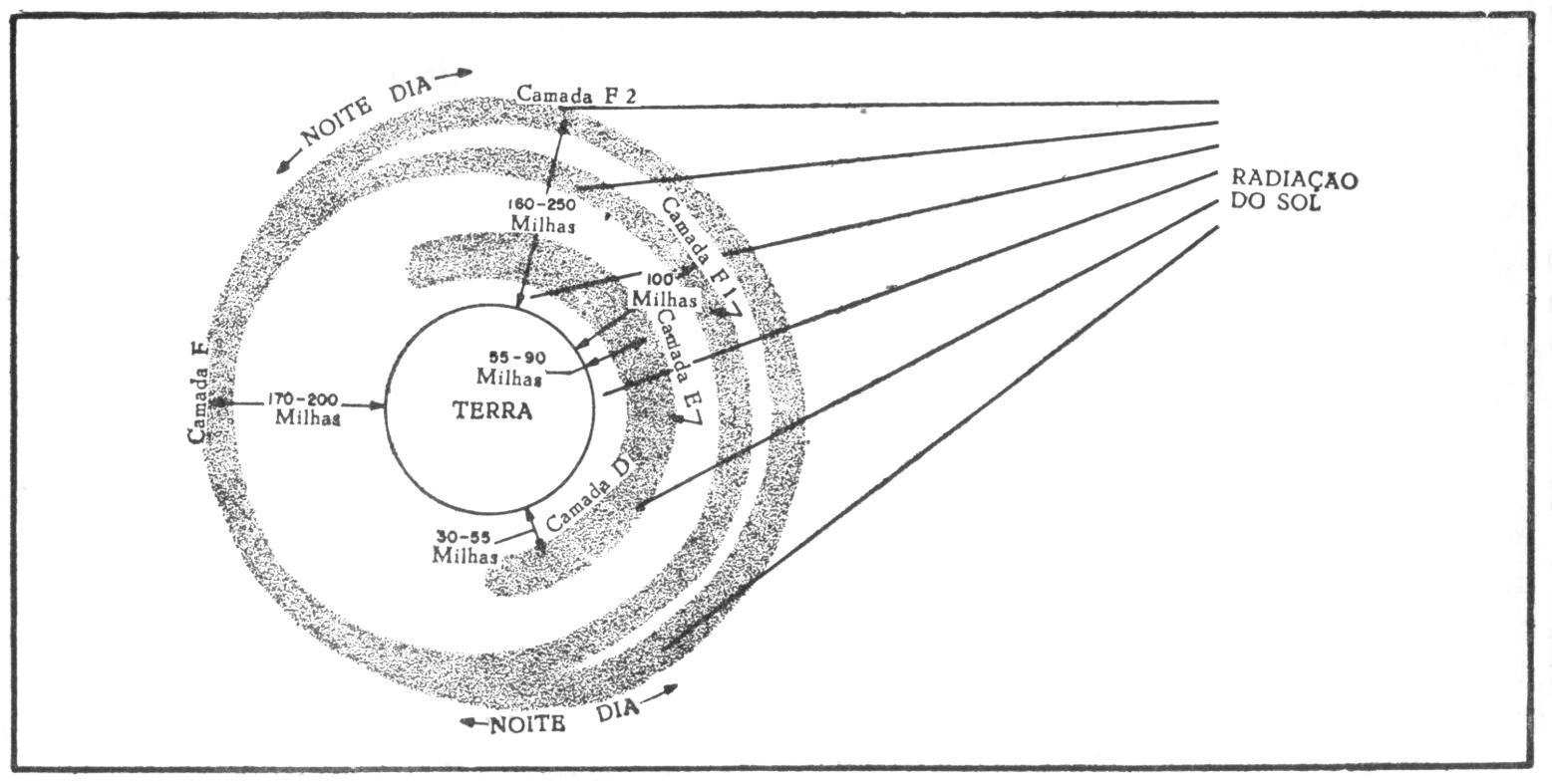
|
|
The layer D extends from 50 km until 70 km, having reduced ionization, and only existing during the daytime; after evening this layer disappears due to the rapid ionic recombination. The layer D refracts only low-frequency radio waves; however, it also causes disturbance in the waves, attenuating or even absorbing them. The layer E extends from 70 km until 100 km, having higher ionization, but also existing only during the daytime. The frequencies refracted by this layer are greather than those refracted by layer D. Occasionally, it appears in this layer the so-called Sporadic E, that can be formed in any time, having duration and dimensions unexpected. Also, it can be formed at night, then altering the path of the transmitted waves, that would be refracted in a lower altitude. The layer F is composed from two distinct layers, F1 (from 100 km until 200 km) and F2 (from 200 km until 400 km). At night, or even during the daytime (depending on the solar cycle), F1 and F2 are indistincts, resulting in an unique layer, F. The ionization level in these layers is the highest, because the ionic recombination is slower due to the atmosphere be less dense. Hence, always a ionized layer is present. These layers are responsible for long-distance transmissions in the HF band. Variations in the IonosphereThe ionosphere, as it was observed, is not homogeneous, neither stable, presenting variations at determined time intervals, or by other means:
Besides the factors above cited, there are other factors that can modify the ionosphere, as for example the so-called "E-Scattering", that happens when the layer F becomes difuse due to irregularities; the received wave becomes a superposition of different refracted waves from different altitudes and positions in the ionosphere. Types of Transmitted WaveBasically, there are two types of electromagnetic waves being transmitted: the terrestrial wave and the skywave. The first is composed of three distinct waves: direct wave, reflected wave, and ground wave, as seen next. The later is propagated towards the atmosphere, refracting in the ionosphere back to Earth, then reaching long distances. Terrestrial WaveThe surface wave is propagated following the surface of the Earth. Due to the terrestrial conductivity, an amount of energy from this wave is absorbed by the surface. The level of absortion varies in a way inversely proportional to the terrestrial conductivity: when higher the conductivity lower will be the absortion, causing the increasing of the inclination angle (the angle between the surface and the transmission plane), resulting in a longer distance reached for the surface wave. For example, transmissions over seas and oceans reach distances considerably longer when compared with transmissions over ground. |
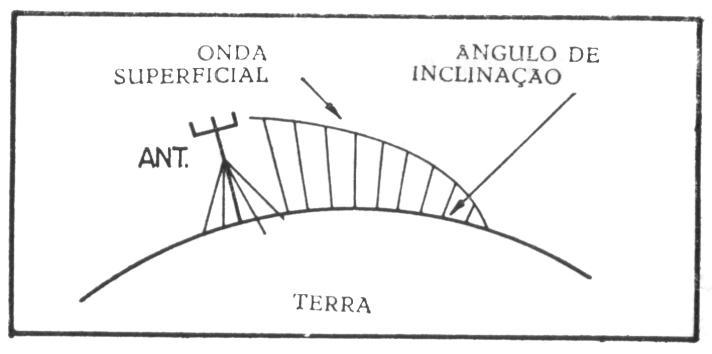
|
|
The direct wave is propagated along an almost straight line from the transmitter to the receiver. The direct wave is slightly inclinated by the tropospheric refraction, causing the inclination towards the terrestrial surface, with the transmissions extending over the horizon. It is also called tropospheric wave. |
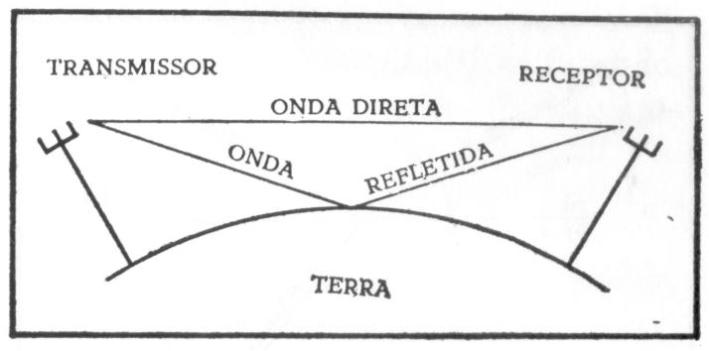
|
|
The reflected wave is the amount of terrestrial wave that is reflected by the surface of the Earth. The way how this wave is reflected depends on the reflection coefficient of the surface and the incident angle. Although this angle and the reflection angle are the same, there is a phase variation between incident and reflected waves, with a phase difference of 180o. This sort of wave is considered to be undesirable in certain cases, can leading to the complete cancellation of the wave in the receiver, if the direct wave and the reflected waves are received with the same magnitude. However, in general the cancellation is partial, because the phase difference is not exactly 180o due to delays, and the reflected wave is received with a lower magnitude, due to differences in the path length. |
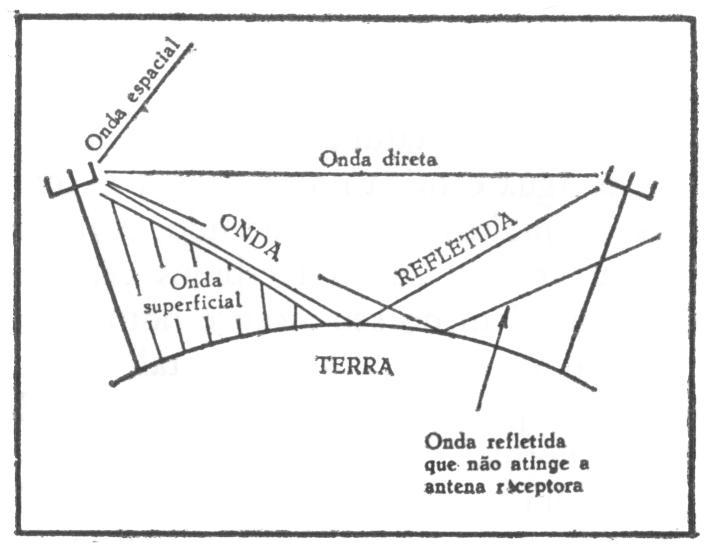
|
SkywaveThe skywave is the wave irradiated in a direction such that the angle with respect to the terrestrial surface is big enough in order to direct the wave to the ionosphere, where the it is refracted back to the Earth, being reflected back to the ionosphere, repeating the process. This is the mode of propagation used by shortwave transmissions, allowing long-distance communication. The ionosphere influences decisively in the skywave propagation. Usually it acts a conductor absorbing an amount of the energy transmitted, but also acts as a "radio mirror", refracting the wave back to the Earth. The capacity on returning a radio wave depends on factors such as ion density, irradiation angle, and transmission frequency. The refraction can even be not realized, with the wave passing through the ionosphere. |
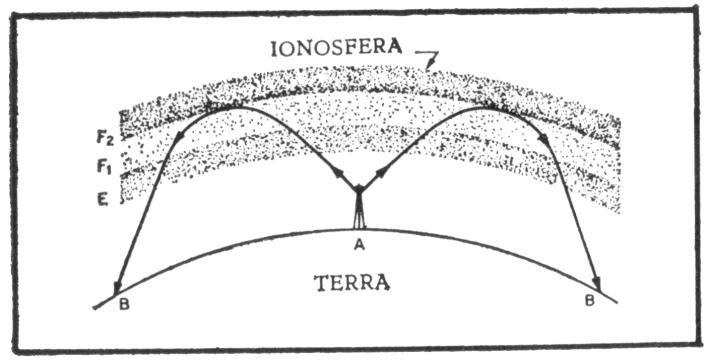
|
|
The distance between the transmitter and the point where the wave returns to the Earth depends on the irradiation angle, that in turn is limited by the frequency since that how higher the frequency being used more difficult is the refraction, although the distance reached is longer. Each layer in the ionosphere can refract radio waves up to a frequency called MUF (Maximum Usable Frequency). There is also a "optimum frequency", OWF (Optimal Work Frequency), that represents a fraction of the MUF. Besides the ionospherr state, factors such as the lenght of the transmission circuit and others described earlier (solar cycle, seasonality, etc) are used to determine the MUF for a given hour and layer of ionosphere, or then a prediction of its value based in observations done along the time. |
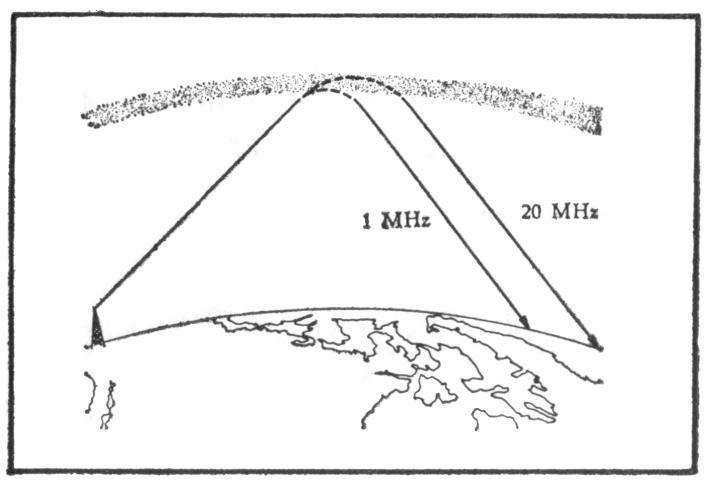
|
|
The irradiation angle is also important. It is known that above a determined frequency the radio waves no more are refracted, passing through the ionosphere. However, if the irradiation angle is reduced, the radio waves can return to the surface of the Earth. The higher angle that still allows the refraction of a transmitted wave is called critical angle for that frequency in particular. The irradiation angle can be approximatedly determined in function of the frequency and the distance between the transmitter and the receiver:
|
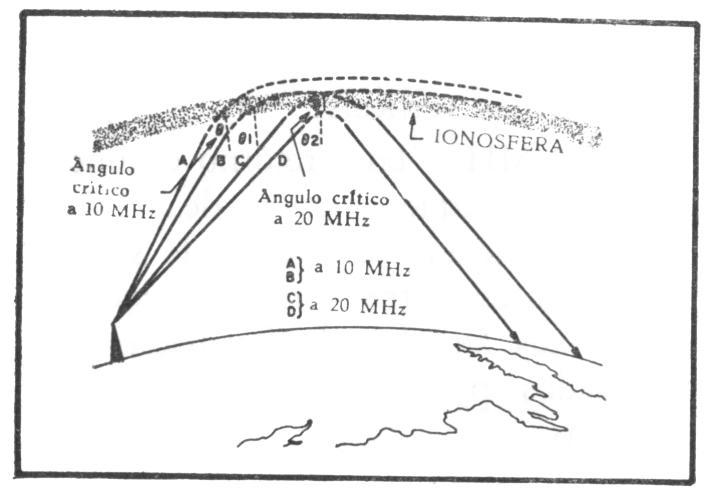
|
|
The path from the transmitter to the point where the refracted wave reaches the Earth is called "jump". Depending on the distance until the receiver, a wave can do more than a jump (the wave reflects in the terrestrial surface back to the ionosphere where is refracted again, and so on). The term "jump distance" is used to design the distance between the transmitter and the return to the Earth, or the distance between each jump. An amount of the irradiated wave can be propagated by ground wave, however reaching short distances from the transmitter. The region in the terrestrial surface that extends from the limits of the ground wave up to the return of the skywave to the Earth receives no signal, being called "skip zone". |
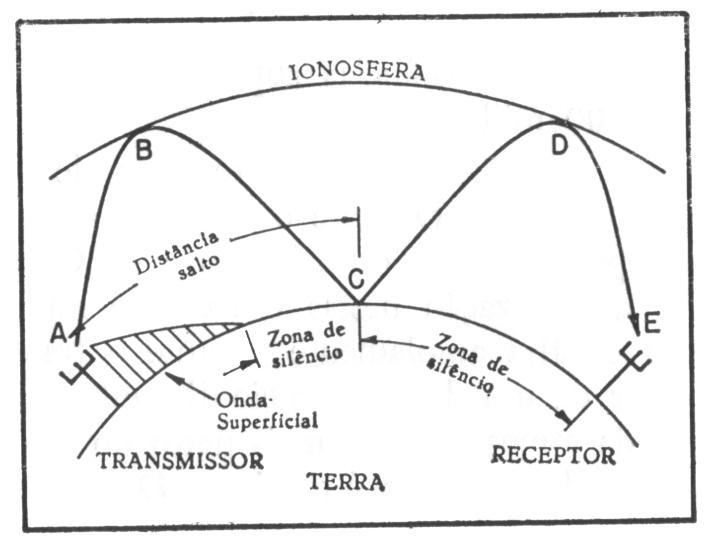
|
|
The layers that compose the ionosphere suffer considerable variations with respect to its altitude, density and thickness, due mainly to variations in the solar activity, as seen earlier. During the period of maximum solar activity the layer F is more dense and occurs in higher altitudes, altering the jump distance and the reachness of the radio waves. At night, with the absence of solar activity, the waves that would be refracted by the layers D and E are now refracted by the layer F, resulting in a longer jump distance. |
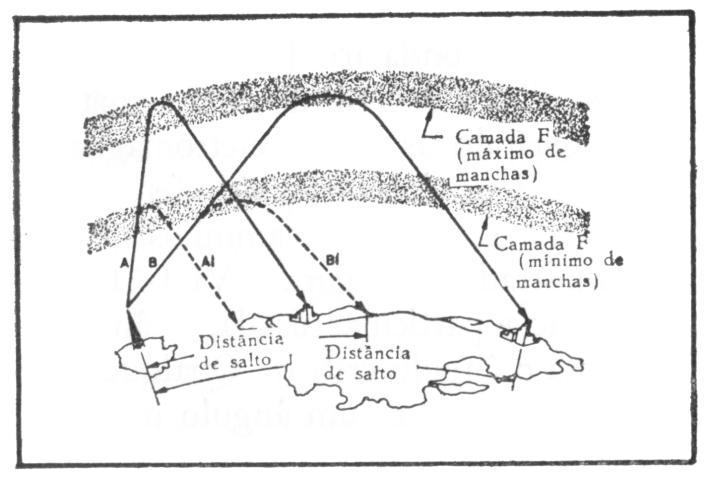
|
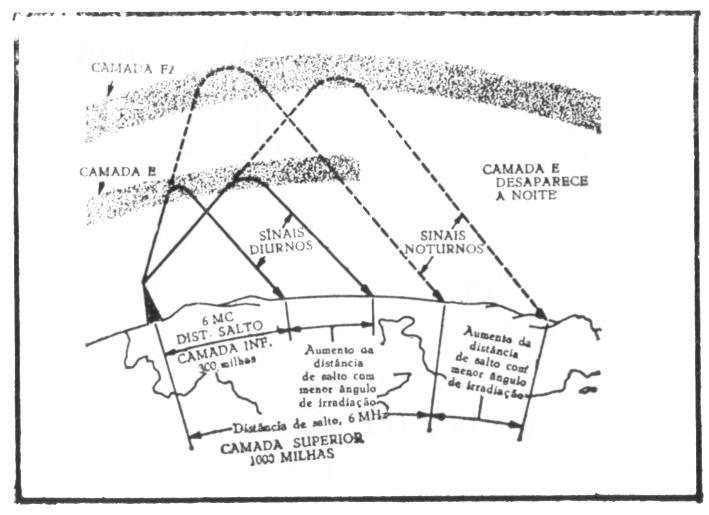
|
Factors of Degradation of the SignalThe transmitted signal doesn't arrive to the receiver with the same power as when it was transmitted. The propagation causes loss of power and attenuation, existing several factors for the degradation, as fading, absortion, and noise. FadingThe fading refers to any fluctuation or variation in the signal intensity that occurs in the receiver during its trajectory since the transmitter. The fading can occur in any time where both the ground wave and the skywave are received. In this case, the two waves can arrive having phase difference, causing the cancellation of the signal. In regions where only arrives the skywave, the fading can be caused by two skywaves following different paths, arriving with a phase difference between them. Variations in the absortion and the path length in the ionosphere can also cause fading. Occasionally, a sudden disturbance can lead to the complete absortion of all energy of the skywave. The fading also occurs when the receiver is located near from the boundaries of the skip zone or when the working frequency has value near to the MUF. In these cases, one can occur the decrease of the signal intensity to levels almost negligible. |
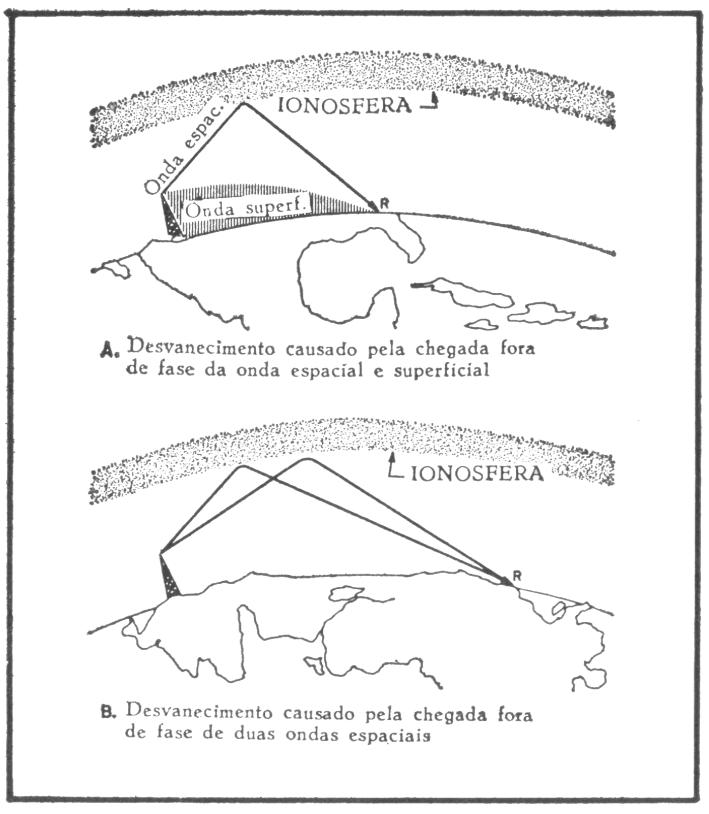
|
|
The main reason for the occurrence of fading in the ionospheric circuits is the multipath propagation, when the received signal is a composition of two or more signals that arrived in the receiver after following different paths. If the waves are received out of phase, a weaker signal will be received. On the other hand, if the waves are received with the same phase, a stronger signal will be received. Small differences in the path length can leave to variations in the phase difference between the received waves. |
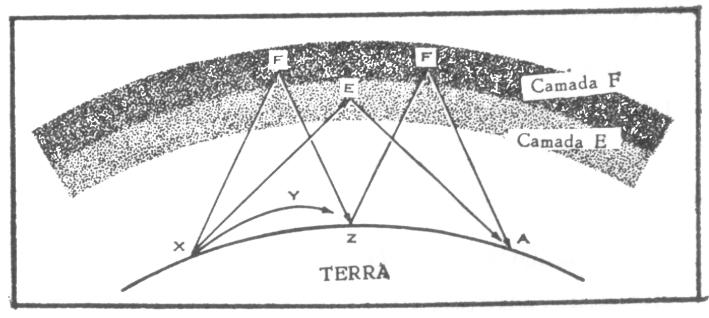
|
NoiseThere are several sources of noise that affect the reception. The noise can be originated from natural sources or artifical sources. In the first case is included the atmospheric noise, usually the main source of noise in the HF band, being higher near equatorial regions, decreasing as the latitude increases. Also, in this case is included the cosmic noise, from the sideral space, that affects the higher frequencies. In the second case can be included all sort of noise caused by ignitions, transmission lines, electronic lamps, electrical machines in general, etc. This noise is directly related to the technological development and/or the populational density in the regions where the signal is received. How the artificial noise tends to be vertically polarized, the use of an horizontal antenna will be aid in the reduction of the noise effects. Ionospheric AttenuationThe layer D causes attenuation in the waves that pass through it. The capacity of absortion varies according to the solar cycle, being higher around the maximum solar. Also, it varies seasonally and during a day, with higher influence in the summer and around the mid-day. As a conclusion, it can be said that the absortion varies according the ionization density in the layer D. Weather ConditionsThe weather is one of the main factors that affects the propagation. Depending on the phenomena, the radio waves can be transmitted up to longer distances, or even be substantially attenuated. Unfortunately, there are no rules that predict the effects of the weather phenomena in the transmission, because the weather variables are complex and subject to frequent variations. Any discussion concerning to it is limited to general terms. The attenuation due to raindrops is higher than the attenuation due to other kinds of water. The attenuation can be caused by absortion, with the raindrops acting as a poor dielectric, absorting the power of the electromagnetic wave and dissipating it by heating or scattering. The attenuation is significative for frequencies above VHF band. The attenuation due to snow is similar to the attenuation due to raindrops. It is more critic for frequencies above 2 GHz, above UHF band. The attenuation due to hailstorm is determined by the size of the stones and their density. As the ice has a lower refraction index, the attenuation due to hailstorm is considerably lower than the attenuation due to raindrops. Bibliographic reference:
|
|
|